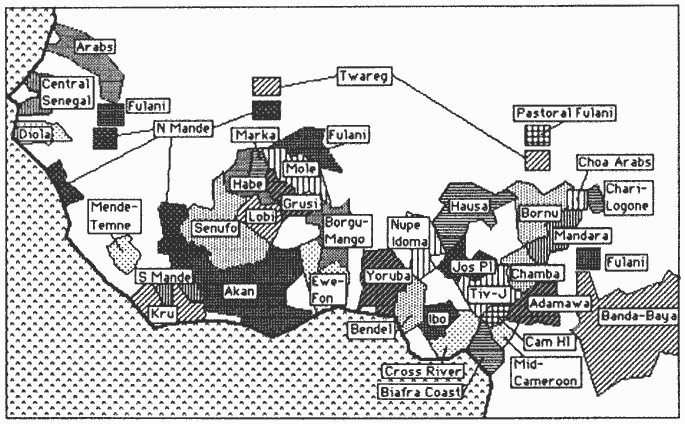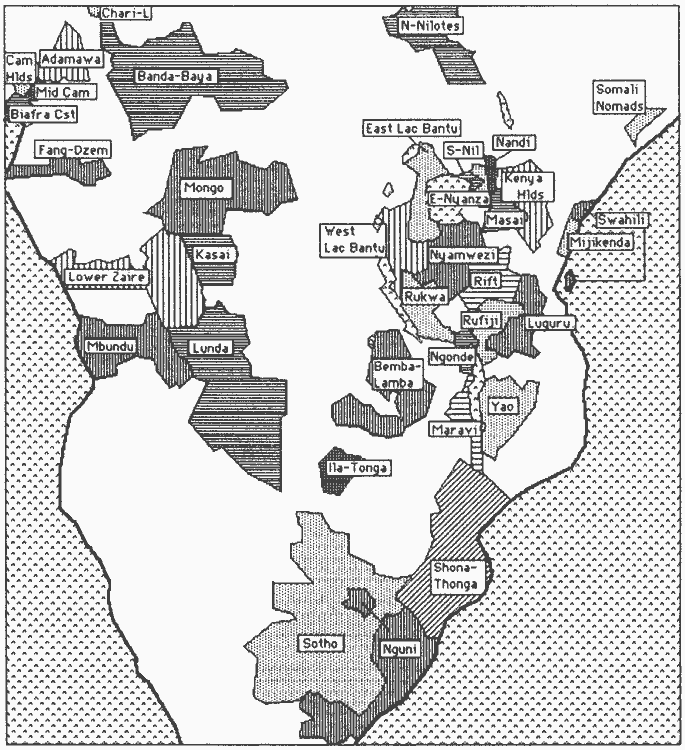The Construction of an Ethnic Nuptiality and Social Structure File
As illustrated in chapter 2, patterns of social organization can be documented on the basis of ethnographic descriptions, and here further use is made of Murdock's Ethnographic Atlas. It was necessary to merge the demographic file, which was mostly region specific, and the ethnographic file, which was ethnic specific. The following principles were used to achieve such a merger:
1. Murdock classified each ethnic group in an ethnic cluster, thereby regrouping populations with similar linguistic, cultural, and organizational patterns. These clusters form the basic unit for establishing the correspondence between the two files.
2. Correspondence was first sought between individual ethnic groups and the regions for which demographic information was available. The matching was performed on the basis of ethnographic maps and the geographical coordinates given in the Ethnographic Atlas. This procedure works well in regions with a single dominant ethnic group. The matter is more complex, however, when a region holds a plurality of ethnic groups, or when an ethnic group is spread over several regions. To alleviate this problem, a nested design with differential weights was introduced.
3. The principles of this design were as follows. If an ethnic cluster was made up of, for example, four ethnic groups residing in areas with demographic information, each ethnic group was given a weight of 0.250. Within a cluster, weights always sum up to unity. If an ethnic group was spread over two regions with demographic information, its social structural characteristics were entered twice along with the two sets of demographic data for these two regions. The total weight for this ethnic group in the cluster was obviously maintained, but the two entries for the same ethnic group were given half this weight (for example, twice 0.125 instead of 0.250).
4. Two ethnic groups may reside in the same area. If they belonged to the same cultural cluster, as defined by Murdock, both received the same regional demographic information, either as their sole demographic input or as a partial input. In the latter instance, weights were further fragmented as outlined by principle 3. Regions with heterogeneity in terms of cluster membership were avoided as much as possible. This principle assured that the correspondence between regions and ethnic clusters was maximized in instances where correspondence between regions and ethnic groups was imperfect.
5. A few deviations were tolerated. The Fulani, Twareg and northern (or "nuclear") Mande groups are spread over much of the West African sahel and savannah, and the ethnic entries in the Murdock file for these

Map 6.9a .
Correspondence Between Areas with Demographic Information and Location of Ethnic Clusters
groups pertain to three particular populations that fall outside the regions with demographic information. In these instances, the ethnographic information was maintained and coupled with demographic information from the Fulani, Twareg, and northern Mande groups elsewhere. A second alteration was performed on Murdock's "Coastal Nigeria" cluster, which was broken up into a new cluster (Bendel) and a set of ethnic groups which were attached to the existing "Cross River" cluster. This new configuration is ethnically more homogeneous and covered fully by demographic information.
6. In instances where demographic information was already ethnic specific (such as Burkina Faso, Gabon, South Africa, most WFS-participating countries) the above problems were absent and a direct match was made.
The outcome of the matching process is shown in map 6.9 for the clusters. The data file contains entries for 170 ethnic groups nested in 69 clusters. The ratio is 2.46 groups per cluster. In further statistical work, all weights were inflated by this ratio in order to respect the real sample size (N = 170) without distorting the nested design.
The following demographic variables were entered:
1. The proportions single women 15–19 and men 20–24. The approximate SMAM values were computed through the conversion formulae given earlier and an estimate of the sex difference in SMAM was added.

Map 6.9b.
Correspondence Between Areas with Demographic Information and Location of Ethnic Clusters
2. Polygyny is measured through the same indices as before, but for the cases without entries for the proportion of married women in polygynous unions ( f ), values were estimated on the basis of the polygyny ratio (M ) in accordance with the regression of f on M (r = 0.75; N = 119 entries). Obviously, this estimation was performed to reduce the number of missing values, which would otherwise lead to a serious selection bias. Hence, the selection bias associated with missing values was considered to be more hazardous than the approximation of f through M.
3. Additional demographic variables are the adult sex ratio (F/M ) and population density. Also the period of observation was added.
The file contains the following ethnographic data:
1. The Murdock scales of the degree of subsistence dependence on respectively hunting/gathering, fishing, animal husbandry, and farming. These scales can be interpreted as the degree (expressed in percentages) of subsistence reliance on any of these sectors.
2. The pattern of exchange of goods and services on the occasion of marriage (EXCH MAR) was measured through the entries in column 12 of the Murdock file and recoded as follows:
0: no exchange or token exchange only (O,T)
1: prestations from the groom's lineage to the bride's lineage (i.e., bridewealth, bride-service, and sister exchange; B,S,X)
2: reciprocal exchange of substantial gifts (G)
3: transfers from the bride's lineage to the new household or the groom's lineage (i.e., dowry; D)
3. The pattern of residence of wives (MARRES) is based on Murdock's column 16 and recorded as:
0: no common residence (O)
1: uxorilocal or matrilocal (U,C,M,A)
2: neolocal (N)
3: virilocal or patrilocal (P,V,D)
4. Lineage organization (LIN) stems from columns 20, 22, and 25 (second digit):
1: strong patrilineal (0 in 22, not in 20, a in 25)
2: patrilineal (0 in 22, not in 20, not a in 25)
3: matrilineal (0 in 20, not in 22, not m in 25)
4: strong matrilineal (0 in 20, not in 22, m in 25)
5: duo + bilateral (0 in 20 and 22 or not 0 in 20 and 22)
In further statistical work codes 1 and 2 are merged to identify patrilinearity and 3 and 4 are regrouped to indicate matrilinearity.
5. The tolerance of or preference for cousin marriages (COUSMAR) are taken from column 25 and coded as follows:
1: no cousin marriage of any kind (N,O,R,S)
2: patrilateral cousin marriage (P,D)
3: evidence of matrilateral cousin marriage (M,G)
4: duolateral, trilateral, and quadrilateral cousin marriage (C,T,Q).
Endogamous marriage is identified by combining the variables "Lineage organization" and "cousin marriage." All societies without cousin marriage of any sort are obviously exogamous. Those with patrilineal organization and patrilateral cousin marriage, matrilineal organization and matrilateral cousin marriage, and those with multilateral cousin marriage are considered as tolerating endogamy (it must be noted, however, that trilateral cousin marriage is an exception and is exogamous).
6. The degree of political complexity (POLCOMP) is obtained from column 32 (second digit):
0: stateless societies
1: existence of petty chiefs
2: existence of large paramount chiefs
3: states
4: large states
Note that Murdock has excluded patterns of political organization introduced by colonial authorities.
7. The variable describing "community size" was directly taken from the Murdock files (column 31), with codes ranging from 1 to 8. The distinctions between the lower codes (1 to 6) do not appear to be very meaningful and the scale can be dichotomized on the basis of the existence of indigenous cities (code 1–6 versus 7,8).
8. Murdock provides a code for the female involvement in agricultural work (FWAGRIC) (column 62). These were recoded as:
0: agriculture of no importance
1: males do more agricultural work than women (M,N)
2: both sexes are equally involved (E,D)
3: females do more agricultural work (F,G)
This variable is important in testing Boserup's proposition (see later discussion), but, as argued by Goody (1976), the validity of this variable is reduced when the analysis is confined to sub-Saharan populations only. In many such societies with entries specifying less female agricultural involvement or equal division of labor, women are involved in trading as well, which enhances their "productive value."
9. The existence of caste and/or class stratification (CCS) is taken from Murdock's columns 67 and 69:
1: unstratified by caste or class (0 in 67 and 69)
2: stratification by wealth only (W in 67, 0 in 69)
3: some despised social groups (0 in 67, D in 69 or D in 67, 0 in 69)
4: moderately stratified (E in 67 or D,E in 69)
5: heavily stratified (C in 67 or 69)
For sub-Saharan populations, a dichotomy can be formed by adding the societies with despised groups, of which there are normally only one or two, to the category of unstratified societies. The numerical share of such groups is very small and the label "despised" is not always accurate since some groups (for example, blacksmiths) are often endowed with magic powers. Obviously, stratification by age grades or other forms of gerontocratic rule are not considered as forms of class or caste stratification.
10. The possibility of women inheriting property is given in Murdock's columns 74 for real property (REAL) and column 76 for movable property other than kitchen utensils and the like (MOVE). The codes are:
1: women inherit (C,D)
2: women do not inherit (M,N,O,P,Q)